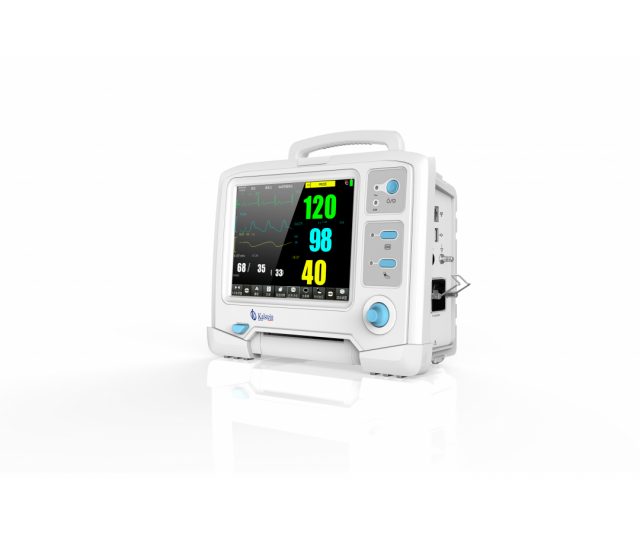A vital signs monitor is electronic devices commonly used in intensive care units, and hospitalization and emergency services to continuously monitor the patient’s vital signs or constants, as these equipment has the ability to continuously detect, process and deploy complex physiological parameters of the patient.
A vital signs monitor depending on your configuration, can measure and display more than 20 different types of parameters, coming from sensors and devices that are placed to the patient, although simpler models can monitor the most basic parameters such as cardiac activity (ECG), non-invasive blood pressure (PNI), respiratory rate (RESP), oxygen saturation (SpO2) and temperature (TEMP).
What is the function of a vital signs monitor?
The main function of a vital signs monitor is to collect, display and store the patient’s main vital signs. Signs will be displayed separately on the computer monitor. In the event that any of them is below or above normal for the patient’s age, or any other adverse activity is generated, an alarm shall be triggered to alert the medical and nursing staff, and in this way the necessary protocols are activated in order to take the necessary measures. These alarms are visual and sound, but can be easily silenced if you are trying to solve the problem that has generated them.
This measurement and recording is achieved in the case of heart rate by amplifying the electrical potentials of the heart, in the case of respiratory rate it magnifies the respiratory movements of the chest, and blood pressure and oxygen saturation will depend on the intensity of the pulse. These vital signs monitors are of great help especially in patients undergoing anesthesia, medicines or any other treatment that determines the need for blood, variation in medication or volume replacement, such as a plasma expander.
How is the monitoring of vital signs carried out?
Monitoring vital signs through these automatic monitors allows these parameters to be detected intermittently, or at preset intervals, saving time and allowing health personnel to perform other tasks.
Each vital sign monitor has a set of alarms that allow alerting in the event of abnormalities in any of the specified parameters, and can store such information for future review.
Some parameters measured by a vital signs monitor
- Non-invasive blood pressure: It is an indicator of the physiological condition of the patient, related to changes in blood volume, the efficiency of heart pumping and peripheral vascular resistance.
- Cardiac activity: the equipment allows to evaluate the rhythm or regularity with which the heartbeat occurs, which are generally two noises and must be rhythmic and regular, occurring 60 to 100 times in a minute, the latter is called heart rate.
- Pulse: refers to the number of heartbeats per minute. The pulse measurement provides important information about any cardiac alteration, and therefore indications about any possible medical condition.
- Oxygen saturation: It’s the amount of oxygen available in the blood. When the heart pumps blood, oxygen binds to the red blood cells and distributes through the body. This measurement is made by the use of pulse oximeters that offer a non-invasive and continuous means to control the percentage of oxygen saturation of hemoglobin in arterial blood.
- Body temperature: The measurement of body temperature can be useful to identify a disease, this measurement is achieved through the use of thermometers who are responsible for measuring body temperature in defined locations, since this parameter is used as a primary indicator of diseases.
What do we offer you in Kalstein?
Kalstein is a company MANUFACTURER of medical and laboratory equipment of the highest quality and that have the most advanced technology at the best prices in the market, so we guarantee you a safe and effective purchase, knowing that you have the service of a solid company and committed to health. This time we present our patient monitor YR 02175. It is a semi-modular monitor of medium and high complexity, specially designed to be used in ICU, Pavilion and Emergency in Adult, Pediatric or Neonatal patients. Among its main characteristics we find:
- The model features a large 12.1-inch TFT color LCD with anti-glare system and Touch Screen function, plus a backup battery of up to 3.5 hrs.
- It can also be connected to a monitoring station and incorporates protocol to connect to HIS, CIS, LIS and PACS systems, and with port for 2G SD memory card. HERE
- Basic parameters included: ECG, ST, Arrhythmia, Respiration, 2 Temperature, SpO2, Noninvasive Pressure, PPI.
- Additional parameters and options: SpO2 Masimo (Rainbow), SpO2 Nellcor, 2 to 8 Invasive Pressures, Analysis of Anesthetic Agents, CO2 (MainStream, SideStream, MicroStream), FiO2, Invasive and Non-Invasive Cardiac Expenditure, Printer Module.
For more information we invite you to take a look at HERE

